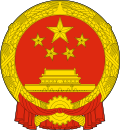Municipality (China)
A municipality ( Chinese 鄕 / 乡 , Pinyin xiāng ) is an administrative unit at the municipality level in the People's Republic of China and the Republic of China in Taiwan .
history
Historically, the municipality as a Chinese administrative unit is an unpaved market place in the country, while the so-called large municipality ( 鎮 / 镇 ) always had a city wall and a garrison. The size of a community has fluctuated greatly over the millennia. In the Western Zhou Dynasty (1045–770 BC) a community consisted of 12,500 households, during the Eastern Zhou Dynasty (770–256 BC) there were 2,000 households, during the Han Dynasty (206 BC) . Chr. - 220 AD) then 10,000 households. When the role of the districts was strengthened in the Tang Dynasty (618–907) , a community consisted of only 500 households and was divided into five villages (then 里 , lǐ ) of 100 households each. This administrative structure was in principle retained until the end of the Qing dynasty in 1911, albeit through the reduced taxation of farmers under Emperor Aisin Gioro Hongli (r. 1735–1795), which resulted in a greatly reduced child mortality in rural areas and a Population explosion led, the number of residents of a single village or a community increased dramatically from around 1800.
People's Republic of China
The municipality level follows in the administrative structure of the People's Republic of China under the county level (districts, banners, autonomous counties, autonomous banners, cities, urban districts, etc.). There are 40,497 units at this level (as of December 31, 2013), of which 11,626 municipalities are roughly comparable to the English township (28.71%).
The community is headed by a mayor ( 鄉長 / 乡长 ), who is usually the deputy secretary of the Chinese Communist Party's community committee . He is supported by the secretary of the community committee, who is usually the vice mayor ( 副 鄉長 / 副 乡长 ). In the autonomous region of Inner Mongolia there are the Sum in Mongolian settlement areas, which are predominantly characterized by cattle breeding , which roughly correspond to the municipalities.
development
More and more municipalities are being converted into larger municipalities ( 鎮 / 镇 ) due to their increased population and a certain degree of urbanization in the center of the settlement .
In some metropolitan areas, e.g. B. Haidian in Beijing , where communities have been overrun by rapid urbanization, a parallel structure was built. Parallel to the existing community, an "area office" ( 地區 辦事處 / oft 办事处 ) was established, which often even has a different place name than the original community. The area office is responsible for the urban, the municipal government for the (still) agricultural population.
Republic of China
In the Republic of China on Taiwan the communities called Zhen ( 鎮 / 镇 ) and xiāng ( 鄉 / 乡 ), which according to the settlement structure with Zhen urban communities ( English urban townships ) and xiāng rural communities (English rural townships are called) .
In 2004, there were 61 urban and 226 rural communities in the Republic of China.
Individual evidence
- ^ Charles O. Hucker: A Dictionary of Official Titles in Imperial China. Stanford University Press , Stanford 1985, p. 240.
- ↑ 罗 竹 风 (主编) :汉语大词典.第十卷. 汉语大词典 出版社, 上海 1994 (第二 次 印刷), p. 658.
- ↑ 范毅軍: 傳統 市鎮 與 區域 發展.聯 經 出版 事業 公司, 新 北市 2005, p. 103. This population explosion and the associated unemployment were the main cause of the social tensions that led to the Taiping uprising in the middle of the 19th century , the Nian Rebellion , the Panthay Rebellion and the Dungan Rebellion , and ultimately the overthrow of the Qing Dynasty.
